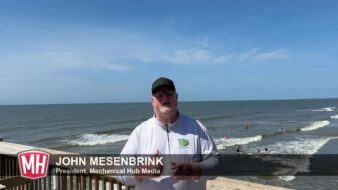
New York City sees it, and they don’t have a water shortage. Nashville Airport sees it, and they’ve got plenty of water. I hear that even Disney in Florida is doing it. We’d all better know how to do it, or we’ll be playing catch-up. What is it?
“It” is cooling- tower-elimination by going to geothermal. If cooling towers were ever “cool,” they have lost their charm (LA Times; NY Times). Cooling towers in commercial buildings are the number two consumer of potable water, using more water than landscape irrigation or the office cafeteria/kitchen facilities. Only the restrooms use more water (national average) than cooling towers in commercial buildings.

In Tennessee, the Nashville Airport is in the process of going 100% geothermal. They will no longer need their cooling towers or boilers. Universities and schools all over the country are going geothermal. In New York City, a new law will require all city-owned buildings to go geothermal when upgrading or building new. What’s the stipulation? They must show a payback in less than 20 years. How much would you like to bet they all fit that category? Save your money, they are all going to be geothermal.
As of 2010, there was 81 billion square feet of commercial space in the US, about 60% of it utilizing cooling towers. That doesn’t count the industrial (commercial and manufacturing) and residential (apartment buildings such as high rise) applications. In fact, the US could save 2 trillion gallons of water each year by converting to geo, not to mention the incalculable combustion heating and resulting CO2 emissions that would be eliminated. That’s enough water savings for the household needs of every person in California AND Georgia for an entire year. Another way to look at 2 trillion gallons is in a swimming pool scenario. A 2 trillion gallon swimming pool 5 feet deep would need to be 1 mile wide by 2000 miles long.
 Geothermal sources can be tied to geothermal heat pumps (GHPs), chillers, reversing chillers, swimming pool heat pumps, ice rinks, you name it. Geothermal loops are an abundant source for heating, and a super-efficient repository for heat-sinking (as in cooling; rejecting heat).
Geothermal sources can be tied to geothermal heat pumps (GHPs), chillers, reversing chillers, swimming pool heat pumps, ice rinks, you name it. Geothermal loops are an abundant source for heating, and a super-efficient repository for heat-sinking (as in cooling; rejecting heat).
Hydronically speaking, geothermal adds unprecedented benefits and possibilities. Moving beyond the scale of single buildings, think of a block, or as it’s sometimes referred to; a “grid.” In the winter the residential apartments are going to need heat at the same time as the commercial buildings are rejecting heat (commercial buildings are often nearly 100% cooling dominant due to internal gains). Instead of those commercial buildings rejecting heat to the outdoors through the cooling towers, that heat is now confined in a geothermal pipe-line, easily distributed to the heat-hungry GHPs serving the residential apartments; energy synergy at its best! It’s not just a theory; read on and I’ll explain how you can learn more about this in a webinar coming next month…

There are several other advantages to cooling tower elimination beyond water and energy savings.

Geothermal is beginning to be legislated into new construction and retrofits. The federal government already does it. Cities and states are working on it. Elimination of combustion heating and the resulting CO2 emissions are a hot topic right now, and only geothermal can make that happen*. It’s only a matter of time until we will all be doing it, so let’s beat the learning curve and get involved now with geothermal industry organizations, GEO and IGSHPA.
CaliforniaGeo is doing a webinar on February 4th that features three case studies that expand upon the replacement of cooling towers with geothermal heat exchange technology. This is the low hanging fruit that can achieve permanent water conservation and increase benefits and comfort. By request, CaliforniaGeo is placing this webinar online, live for a second time. As I mentioned earlier, one of the case studies will illustrate thermal load shifting/sharing.
 https://www.californiageo.org/news/two-californiageo-webinars-could-boost-your-sustainability/
https://www.californiageo.org/news/two-californiageo-webinars-could-boost-your-sustainability/
 Jay Egg is a geothermal consultant, writer, and the owner of EggGeothermal. He has co-authored two textbooks on geothermal HVAC systems published by McGraw-Hill Professional. He can be reached at jayegg.geo@gmail.com.
Jay Egg is a geothermal consultant, writer, and the owner of EggGeothermal. He has co-authored two textbooks on geothermal HVAC systems published by McGraw-Hill Professional. He can be reached at jayegg.geo@gmail.com.
*…with the exception of electric resistance heating. Electrical resistance heat consumes 300% to 500% more energy than a GHP.




Join the conversation: